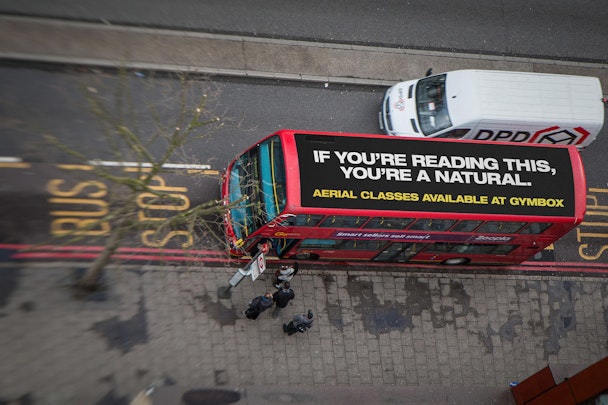It’s time to be real about my fake ads
‘Fake it until you make it’ is an ethos that Gymbox’s Rory McEntee has wholeheartedly embraced. He offers his truth with proof that a spoof can raise the roof.

/ Gymbox
Almost a year ago to the day, I created my first fake ad (for Gymbox). At the time, I didn’t even consider it fake. I couldn’t have foreseen that over the next 12 months, I would be hooked on a creative treadmill of fake ad executions that was hard to get off.
After all, I was getting more exposure than ever. Nor did I expect the criticism, backlash and debate that the series of adverts would cause in adland.
But like an addict, I was constantly looking for my next big idea to fake and bring to market. It seems I’m not alone with many brands and individual creatives who have an idea for a brand following suit and are quick to share their mock-ups with the world. So what’s the big deal?
Not all fake ads are created equal
First things first, we need to distinguish between two types of fake adverts. I see a lot of inconsistencies out there. Forget about media and FauxOOH for a moment. There are fake adverts created by brands, such as Maybelline eyelashes or the Gymbox bus ad, and then there are fake ads created by people not associated with the brand, such as the recent EasyJet ad.
When clients or brands such as ourselves sit in a room and decide to fake an ad, there is some level of intent to deceive audiences to gain something. Be it sales or PR coverage.
Is there any harm in faking these adverts?
I’m still not sure we’re causing much damage, but rightly, we open ourselves up to criticism. Particularly from righteous creative directors and media owners who are missing out on their fame or cut.
When an individual who has a great idea for a brand they do not necessarily work for, is there anything wrong with the world seeing their creative concept, which creates conversation and pushes creative boundaries?
(Un) intentionally misleading
During King Charles III’s Coronation, an ad from Guinness went viral, earning plaudits and awards beckoned. Shared by BBC reporters to Made in Chelsea stars as a legitimate ad, it turned out it was made by Anthony Smith, a creative director in Sydney with no affiliation with the brand.
More recently, Tom Birts, a copywriter (also in Oz, which makes me think the + 10 hours they have on us back in the UK gives them a head start on all this great reactive work we are seeing), posted off his own back a humorous response to the British Airways ad for EasyJet which again went viral.
Are these unintentionally misleading or guilty of being deliberately deceptive? In the latter’s case, the man in question was very transparent in his post, leading with the comment, ‘If I were EasyJet…’
Lost in translation
But herein where lies the problem. Context, intent and impact vary across those sharing this work.
While Tom was transparent in his creation of this fake ad, others weren’t, and by the time it traveled from Western Australia to London via wannabe LinkedIn-fluencers, the original context was lost. But we were all too quick to judge and castigate this ad for trying to fool us all.
But I’d hope Tom took any criticism of his advert on the chin. After all, he did nothing wrong, and we should applaud his creativity.
Sorry, not sorry
But here is the thing, and I know this as someone in the very slim cross-section of calling out Anthony Smith a year ago and someone who has faked an ad, people who are creating these fake ads don’t give two hoots about your opinion. In fact, he was quite proud of the post and thought it did well, on top of the clever idea, because many people wondered why an Irish brand would mark the coronation.
These ads are created to provoke a reaction. I am a brand owner and have created fakes. Slap on the wrist for me, but while I will be criticized for a lack of authenticity and truthfulness, the reality is my fake ad is driving sales, getting way further reach than a ‘real’ advert and is content within itself.
Like Anthony before him, Tom will dine off this for years to come and get further opportunities on the back of creative thinking that most brands would die for. And here’s the thing, both ads were, in my humble opinion, better than anything the brands had come up with. EasyJet had a real OOH ad up the same week which got totally overshadowed. Bravo Tom, bravo.
Tail-wagging the dog
Some might argue that creativity has been stifled by the lack of innovation from media owners which is maybe why I faked an ad on top of a bus when I realized I couldn’t do it for real. Others might say that it is a lazy and myopic view and I just lied to people. I’m always happy to have that debate.
But as the brand owner, I believe that I get to choose how to market my brand and I can control that.
Where it gets a bit hazy is when super creative people take your brand and your assets to create executions that go viral. If I was EasyJet, would I be pissed that I didn’t come up with the idea myself or grateful for the free exposure?
I’m not sure.
Guinness might not have been overly pleased that it inadvertently welcomed Charles’ reign. And Burger King may rue a spoof ad that circulated mocking “missing” Kate Middleton.
Regardless, the rising reach of fake does feel like a shift, and I love to see that the tail is now wagging the dog with no respite in sight. That’s the truth.
Editor’s note: Rory makes a strong case. However, as a publication that covers ads, we have a responsibility to provide readers the as clear a picture as possible. We ask agencies about media plans driving creative to do just that. We are less likely to cover a campaign we know isn't running IRL. These lines are blurring. With the rise of FauxOOH in particular, the fake ad is a legitimate tactic and we need to better understand the impact of this work. Let us know your thoughts @ editorial@thedrum.com or on LinkedIn.

